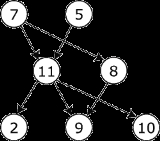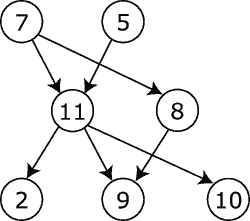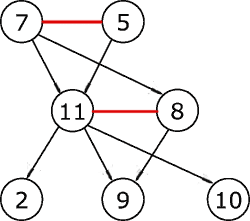
Moral graph
Encyclopedia
A moral graph is a concept in graph theory
, used to find the equivalent undirected form of a directed acyclic graph
. It is a key step of the junction tree algorithm, used in belief propagation
on graphical models.
The moralized counterpart of a directed acyclic graph is formed by connecting nodes that have a common child, and then making all edges in the graph undirected. The name stems from the fact the two nodes that have a common child are said to be married. Equivalently, a moral graph of a directed acyclic graph G is an undirected graph in which each node of the original G is now connected to its Markov blanket
.


Graph theory
In mathematics and computer science, graph theory is the study of graphs, mathematical structures used to model pairwise relations between objects from a certain collection. A "graph" in this context refers to a collection of vertices or 'nodes' and a collection of edges that connect pairs of...
, used to find the equivalent undirected form of a directed acyclic graph
Directed acyclic graph
In mathematics and computer science, a directed acyclic graph , is a directed graph with no directed cycles. That is, it is formed by a collection of vertices and directed edges, each edge connecting one vertex to another, such that there is no way to start at some vertex v and follow a sequence of...
. It is a key step of the junction tree algorithm, used in belief propagation
Belief propagation
Belief propagation is a message passing algorithm for performing inference on graphical models, such as Bayesian networks and Markov random fields. It calculates the marginal distribution for each unobserved node, conditional on any observed nodes...
on graphical models.
The moralized counterpart of a directed acyclic graph is formed by connecting nodes that have a common child, and then making all edges in the graph undirected. The name stems from the fact the two nodes that have a common child are said to be married. Equivalently, a moral graph of a directed acyclic graph G is an undirected graph in which each node of the original G is now connected to its Markov blanket
Markov blanket
In machine learning, the Markov blanket for a node A in a Bayesian network is the set of nodes \partial A composed of A's parents, its children, and its children's other parents. In a Markov network, the Markov blanket of a node is its set of neighbouring nodes...
.



